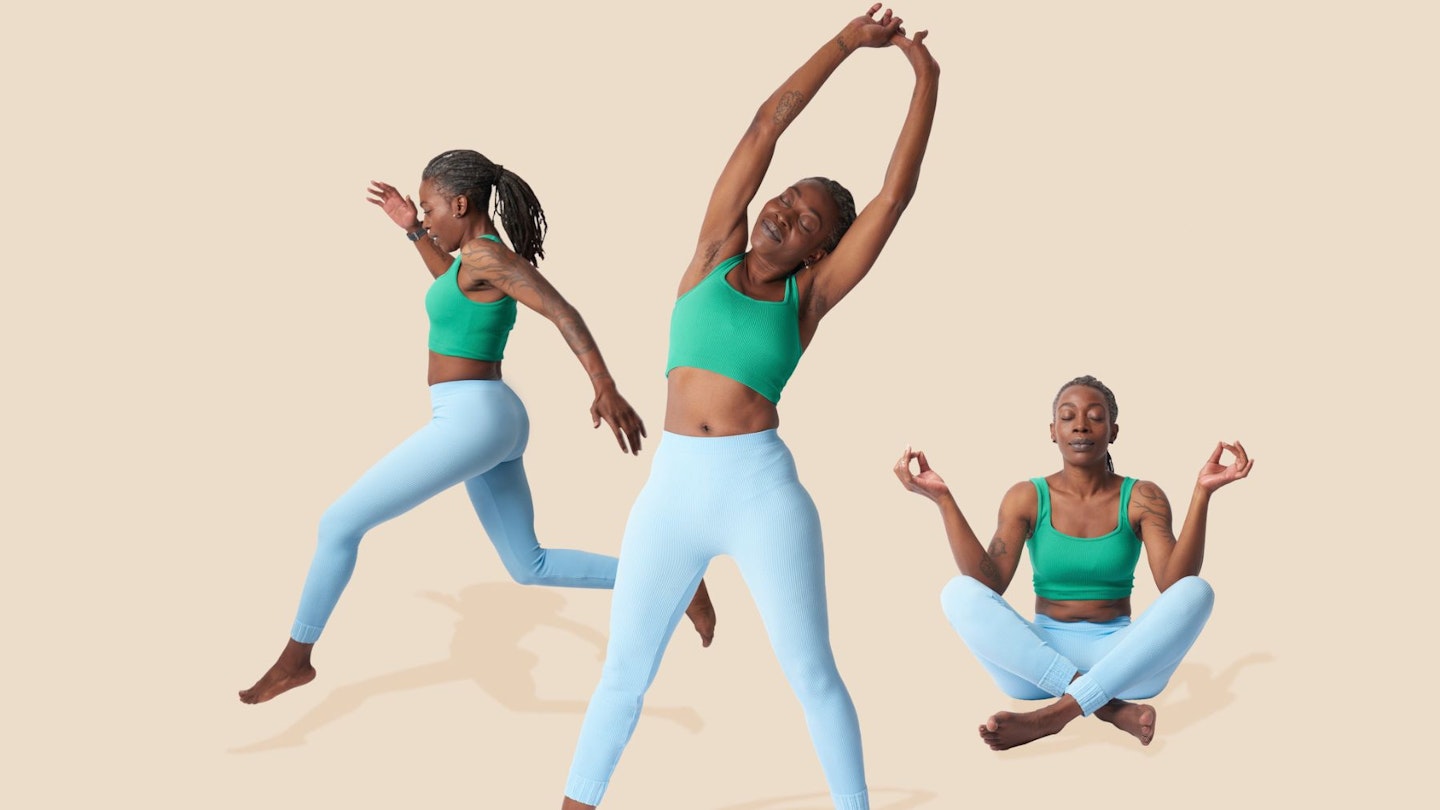Imagine a place where strength meets serenity, and mindfulness fuses with physical mastery - welcome to the benefits of yoga. The ancient practice that is full of wisdom and countless ways of getting your body and mind, feeling healthier. Requiring little in the way of gym equipment and stretching beyond its roots in ancient India, yoga has seamlessly woven its way into our modern lives, offering peace and calm in a world of chaos.
Yoga is a holistic discipline that is said to unite the mind, body, feet and spirit in pursuit of balance and overall wellbeing. The word 'yoga' originates from the Sanskirt word 'yuj', which means to unite. At its foundation, yoga aims to unite a range of techniques, from physical postures and controlled breathing, to meditation and mindfulness. But, it's the postures that are most commonly associated with yoga. Such as Mountain Pose, Warrior Poses and Downward Dog, to name a few.
Although yoga is renowned for these graceful poses and zen-like practice, the true marvel of yoga lies in its transformative powers for both the body and mind. We spoke to Nick Higgins, Co-Founder and Head of Yoga Teaching at one of the world's largest yoga businesses, Hotpod Yoga, to greater explore the path of wellbeing that stretches far beyond just the physical. So, join us on a journey as we uncover the eight remarkable benefits of yoga.
The eight benefits of yoga
1. Supports a stronger, healthier body
Regular practice can lead to better posture, improved core strength and a leaner, healthier body. It's also effective in promoting better circulation and digestion, making it a valuable practice for achieving a more robust and vibrant body. But, it doesn't stop there, Nick says: "yoga involves a wide range of postures and exercises that engage various muscle groups. This helps build strength, tone muscles, and improve overall body composition. Additionally, it encourages proper alignment and posture, reducing the risk of musculoskeletal issues, which can cause significant aches and pain."
2. Builds mental and physical resilience
Contrary to popular belief, yoga isn't just about the physical postures. It's a practice of resilience as well.
"Yoga helps build resilience by teaching students to adapt and find balance in challenging postures and situations. It cultivates mental fortitude through practices like breath control and meditation, helping individuals cope with stressors both during class and outside it." In essence, yoga teaches you to stay calm, centred and adaptable, which is a valuable skill in our fast-paced world.
3. Improves cardiovascular health
Yoga isn't a high-intensity cardiovascular exercise. But, by fostering a holistic approach to wellbeing, it can be a powerful ally in maintaining a healthy heart and reducing the risk of cardiovascular diseases. In particular, Vinyasa classes can elevate heart rate and improve circulation, while focusing on breathing can enhance lung function and oxygenation of the body.

4. Supports better sleep
Another one of the benefits of yoga is it can help you achieve better sleep. Nick explains, "the relaxation techniques used in yoga, combined with stress reduction, can help calm the mind and prepare the body for restful sleep. This can be particularly beneficial for those who have a busy mind and who may typically struggle with sleep."
Moreover, yoga can also be used to relieve tension in the body, particularly in areas such as the neck, shoulder and lower back. These are three common areas of discomfort that can interfere with a good night's sleep. So, through mindfulness and meditation, yoga enhances that self-awareness we'll come onto later. Therefore, this enables you to recognise and address the factors that may be contributing to your sleep troubles.
5. Improves flexibility and joint mobility
Through a combination of gentle stretches, controlled movements and various poses, yoga helps with alleviating tension in muscles and connective tissues found around joints. Over time, these stretches lead to an increased range of motion and improved joint mobility - this is why many newcomers need a yoga block to help them in the practice, but feel able to move on without one as they progress. Regular practice of yoga not only promotes the lubrication of joints, but also strengthens the surrounding muscles. This provides added support and stability. So, yoga could be a great choice for individuals who want to improve their overall physical comfort and alleviate stiffness.
6. Reduces stress and improves focus
Letting go of distractions can be difficult. So, Nick suggests that yoga can help with overall clarity. "Yoga places a strong emphasis on training the mind to become more present in the moment. Through meditation, breathwork, and physical practice, you can learn to calm the mind, reduce stress levels, and enhance focus. These skills can be applied in daily life, improving productivity and mental clarity."

7. Cultivates greater self-awareness
Yoga is a journey inward, and as Nick describes "encourages self-reflection and introspection. Through regular practice, you can become more attuned to your body, thoughts, and emotions. This heightened self-awareness can lead to a deeper understanding of one’s own needs and desires, fostering personal growth and self-acceptance."
8. Boosts recovery and reduces the likelihood of injuries
Overall, yoga perfectly complements other forms of exercise and sports, in turn assisting with a safer and faster recovery process. For example, the practice of mindfulness and breath control in yoga teaches yogis to be more present and attentive to their bodies. Thus, making them more attuned to potential overexertion warning signs, whether they are on a run or doing some strengthening work with kettlebells.
In general, "yoga promotes balanced strength and flexibility, which can help prevent injuries. It also aids in post-injury recovery by gently building strength, increasing circulation to injured areas, and promoting a mindful approach to movement, reducing the risk of re-injury."
The benefits of yoga: FAQs
What does a typical beginner yoga class look like?
If you're a first-time yogi, there's no reason to be worried. A beginners class is designed to be welcoming and accessible to those who are new, or relatively new, to the practice. Nick talks us through one of his beginner classes.
"A typical beginner’s class would generally start with a gentle warm-up, using poses such as ‘Child’s Pose’, a forward-bend in a kneeling position which helps stretch out your back and the muscles around your hips; or ‘Cat and Cow’, which is a gentle pose between two positions that helps to loosen up the body and steady the mind.
"When everyone is nice and warm, a class would typically move into a flow sequence, incorporating poses such as ‘Warrior 2’, a standing position that strengthens the legs whilst opening up the hips and chest, and ‘Triangle Pose’, to help strengthen the legs and back, whilst stretching out the thighs, then bringing in some Vinyasa breakdowns (such as using poses called ‘Up Dogs’ and ‘Down Dogs’ that strengthen, elongate and stretch the muscles).
"The class would usually move towards including a mix of standing, seated, and lying-down postures that build strength and flexibility, before ending with a period of relaxation, when the instructor reinforces the importance and benefits of the practice, leaving students feeling calm and settled after their first class."
He also reiterates the importance of instructor support. "Throughout the class, the instructor should offer clear, encouraging cues to help students get into and out of poses safely. They would typically provide individual adjustments and modifications based on each student’s needs, ensuring proper alignment, and preventing strain."
For an added dynamic element, yoga can also be practiced in warm environments. "Warm and controlled heat allows for a comfortable, immersive experience. This is because you can turn up the dial on a typical yoga class and enhance flexibility and detoxification, without the more extreme heat that you’d find in other hot yoga practices, such as Bikram Yoga."

Should I practice yoga everyday?
The decision whether to practice yoga everyday or not is a personal one. Practicing yoga daily could help banish the winter blues and offer numerous benefits, as we've just explored, such as improving cardiovascular health, and mental and physical resilience. Saying that, it's essential to listen to your body and avoid overexertion. Depending on your yoga experience level, daily practice may vary from a restorative session to a more vigorous routine. Consulting your yoga instructor can help you determine a suitable practice frequency that aligns with your overall goals and fitness level.
The key is to find a balanced and sustainable routine that suits your lifestyle and improves your physical and mental health.
How long does it take to see results from yoga?
There is no 'timeline of results' when it comes to yoga. Some people may notice subtle changes in their body and mind after just a few sessions, like improved relaxation and stress reduction. However, more substantial physical benefits, like the increased flexibility we were talking about earlier, will become noticeable later on in your journey. Other physical benefits can take even longer. Things like significant changes in cardiovascular health and muscular strength may take several months to a year.
You'll find the more you commit to your yoga practice, the sooner you'll experience it's numerous benefits. Ultimately, your yoga journey is about personal growth and holistic wellbeing. So, the pace you see results at can vary depending on your goals and the effort you're willing to put into your classes. Seeing results is all about consistency and dedication.
About the expert
This article contains expert advice from Nick Higgins, a Co-Founder and Head of Teaching at Hotpod Yoga. He's practiced yoga for over 16 years. In 2012 he completed his 200-hour yoga teacher training (YTT) in Morocco, and committed to yoga full-time. Since then, his focus has been on a form of yoga called Vinyasa flow, working mainly within hot or heated yoga spaces. Nick has taught thousands of classes, set-up Hotpod Yoga's YTT school and developed a dedicated team of instructors across the globe.
Gemma Lavers is a Health & Fitness Writer for What's The Best. When she’s not travelling or writing, Gemma loves spending her weekend completing home workouts, or attending yoga, Pilates or Zumba classes.
Subscribe to the What’s The Best Newsletter to keep up to date with more of the latest reviews and recommendations from the rest of the What’s The Best team.
